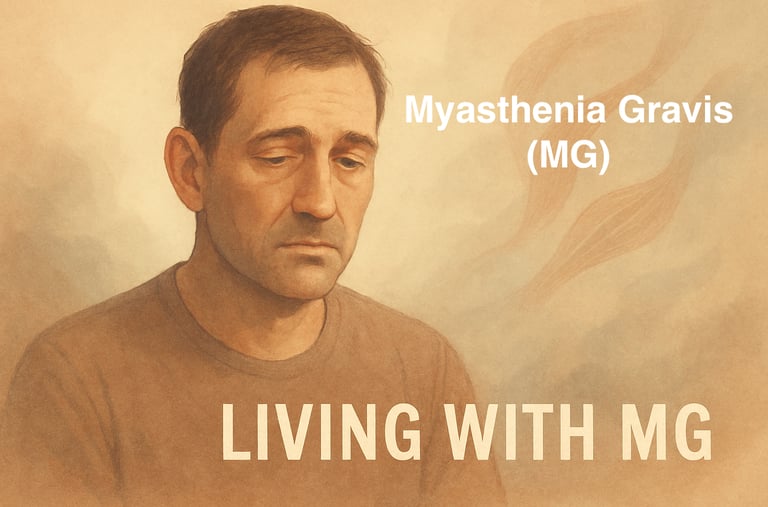Stay updated on what is trending in health. Discover tips and resources for a healthier, balanced life.
Myasthenia Gravis (MG): What You Need to Know
Learn about myasthenia gravis — a rare autoimmune condition causing muscle weakness. Discover symptoms, causes, treatments, and tips for living well with MG.
DISEASES AND CONDITIONS
Dr. S. Ali
8/13/20255 min read


If you’ve ever felt unexplained muscle weakness that seems to get worse the more you use those muscles, you might wonder — could it be something serious? One rare but important condition that causes this is myasthenia gravis. While the name sounds intimidating, understanding it can make it a lot less scary. Let’s break it down together.
What Is Myasthenia Gravis?
Myasthenia gravis (often called MG) is a long-term autoimmune condition. That means your immune system — the body’s defense against germs — mistakenly attacks parts of your own body. In myasthenia gravis, it targets the communication between your nerves and muscles, making it harder for your muscles to work properly.
The main sign? Muscle weakness that gets worse with activity and improves with rest.
Why Does It Happen?
In a healthy body, nerves release a chemical messenger called acetylcholine that tells your muscles to contract. In myasthenia gravis, your immune system produces antibodies that block or damage acetylcholine receptors on muscle cells. This interruption is like cutting the phone line between your brain and your muscles — the message just doesn’t get through properly.
Doctors aren’t exactly sure why this immune mix-up happens, but genetics, other autoimmune conditions, and problems with the thymus gland can play a role.
Common Symptoms of Myasthenia Gravis
The symptoms can vary, but some common ones include:
Drooping eyelids (ptosis) – One or both eyelids may sag, especially later in the day. This often worsens with fatigue or prolonged screen use and may temporarily improve after resting.
Double vision (diplopia) – Trouble focusing or seeing clearly when both eyes are open. This occurs due to weakened eye muscles and can make driving or reading dangerously difficult.
Difficulty speaking (dysarthria) – Your speech may sound slurred or nasal. Voice changes are often noticeable after long conversations and may be mistaken for exhaustion or a neurological issue.
Trouble chewing or swallowing – Eating a meal can become tiring. Some patients choke easily or avoid dense foods like meat, leading to unintended weight loss.
Weakness in arms or legs – Tasks like climbing stairs or lifting objects get harder. Unlike typical fatigue, this weakness improves significantly with rest but returns quickly with activity.
Neck weakness – Your head may feel heavy or harder to hold upright. A "dropped head" posture is common in advanced cases and can cause chronic neck pain.
The key feature is that these symptoms often worsen with activity and improve after resting.
How Is Myasthenia Gravis Diagnosed?
If a doctor suspects myasthenia gravis, they might recommend:
Physical exam - Checking muscle strength and reflexes. Your doctor will look for hallmark signs like worsening weakness with repeated movements (fatigability) and observe how your eyelids or limbs respond to activity. This helps distinguish MG from other neurological conditions.
Blood tests - Looking for specific antibodies linked to MG. The most common tests detect acetylcholine receptor (AChR) or muscle-specific kinase (MuSK) antibodies, which confirm an autoimmune response. About 10-15% of patients test negative but may still have myasthenia gravis (seronegative MG).
Electromyography (EMG) - Testing how well your muscles respond to nerve signals. This involves small electrical pulses to measure muscle fatigue patterns. A repetitive nerve stimulation test may show decreasing responses, typical of myasthenia gravis's "waxing and waning" weakness.
Imaging tests - Scans to see if the thymus gland is enlarged or has a tumor. CT or MRI scans of the chest can reveal thymomas (tumors) present in 15% of myasthenia gravis patients. Even without tumors, thymic abnormalities are common and may guide treatment decisions.
Getting an accurate diagnosis is important because MG symptoms can look like other conditions.
Treatment Options for Myasthenia Gravis
There’s currently no cure for myasthenia gravis, but treatments can help control symptoms and improve quality of life:
1. Medications
Symptom-relieving drugs: These help improve nerve-to-muscle communication, reducing weakness and fatigue. They work quickly but may require frequent dosing.
Long-term immune-modulating drugs: Used to slow disease progression by regulating the overactive immune system. These take time to show full effects but help reduce reliance on other medications.
2. Immune System Therapies
Steroids: Often used for rapid symptom control, but long-term use may have side effects.
Other immunosuppressants: Help reduce the immune system’s attack on muscle receptors, leading to sustained improvement.
3. Short-Term Emergency Treatments
Plasma exchange (plasmapheresis): Filters harmful antibodies from the blood, providing fast but temporary relief. Useful during severe flare-ups or before surgery.
Intravenous immunoglobulin (IVIG): Uses purified antibodies to temporarily block the immune attack. Often given over several days for quick stabilization.
4. Surgery (Thymectomy)
Removal of the thymus gland, which plays a role in abnormal immune responses in myasthenia gravis. This is especially recommended if the gland is enlarged or has abnormalities. Benefits may take months to appear.
5. Emerging & Specialized Treatments
Newer therapies target specific parts of the immune system, offering alternatives for difficult-to-treat cases. These may be considered if standard treatments aren’t effective.
General Considerations:
Treatment plans are personalized based on symptom severity, antibody status, and overall health.
Many patients use a combination of therapies for best results.
Regular monitoring is important to adjust medications and check for complications.
Living Well with Myasthenia Gravis: Practical Tips for Daily Life
While MG requires adjustments, these strategies can help you conserve energy and maintain independence:
Energy Management
Prioritize & Pace
Schedule demanding tasks (like grocery shopping or work meetings) during peak energy hours—often mornings for MG patients.
Break tasks into smaller steps. For example, fold laundry in batches rather than all at once.
Strategic Rest
Take 10-15 minute breaks between activities. Even sitting quietly with closed eyes helps recharge muscles.
Use voice-to-text apps to "rest" your hands when typing feels exhausting.
Nutrition & Eating
Meal Modifications
Choose soft, moist foods (soups, mashed potatoes, smoothies) when chewing is difficult.
Cut food into tiny pieces to reduce effort. A small food processor can help.
Eat smaller, more frequent meals to avoid fatigue from long dining sessions.
Swallowing Safety
Sit upright while eating, and take small sips of water between bites.
Avoid dry, crumbly, or sticky foods (like bread or peanut butter) during symptom flares.
Symptom Triggers to Avoid
Environmental Factors
Heat and humidity often worsen weakness. Use cooling vests or air conditioning in summer.
Stress can trigger flares. Try mindfulness apps or gentle yoga (seated poses work well).
Medication Caution
Some antibiotics, blood pressure drugs, or muscle relaxants may exacerbate MG. Always confirm with your neurologist before starting new medications.
Assistive Tools & Adaptations
At Home
Install grab bars in showers and use a shower chair to conserve energy.
Pre-chop vegetables or batch-cook meals on high-energy days.
On the Go
Use a rolling cart or backpack for heavy items instead of carrying them.
Keep a foldable cane in your car for days when leg weakness flares.
Emotional Wellbeing
Support Systems
Join an MG patient community (like the Myasthenia Gravis Foundation) for shared tips and encouragement.
Educate family/friends about "invisible symptoms" like fluctuating strength.
Mental Health Check-Ins
Fatigue and weakness can be frustrating. Therapy or support groups help manage emotional strain.
Remember:
MG symptoms vary day to day—be kind to yourself on harder days. With treatment and self-care, most patients maintain careers, hobbies, and rich social lives.
Possible Complications
One serious complication is myasthenic crisis — severe muscle weakness affecting breathing. This is a medical emergency and requires immediate hospital care. While rare, it’s important to know the signs, such as sudden shortness of breath or trouble swallowing.
The Bottom Line
Myasthenia gravis may be rare, but it’s a condition worth understanding. With early diagnosis, proper treatment, and some lifestyle adjustments, many people manage it successfully. If you notice unexplained muscle weakness, especially if it worsens with activity, don’t ignore it — talk to your doctor. The sooner you find answers, the better your chances of staying healthy and active.
Sources:
1. Myasthenia Gravis Foundation of America (MGFA)
https://myasthenia.org
2. National Institute of Neurological Disorders and Stroke (NINDS) – Myasthenia Gravis Information
https://www.ninds.nih.gov/Disorders/All-Disorders/Myasthenia-Gravis-Information-Page
3. Mayo Clinic – Myasthenia Gravis Overview
https://www.mayoclinic.org/diseases-conditions/myasthenia-gravis/symptoms-causes/syc-20352036
4. Johns Hopkins Myasthenia Gravis Center
https://www.hopkinsmedicine.org/neurology_neurosurgery/centers_clinics/myasthenia_gravis
5. Muscular Dystrophy Association (MDA) – MG Resources
https://www.mda.org/disease/myasthenia-gravis
6. MedlinePlus (NIH) – Myasthenia Gravis
https://medlineplus.gov/myastheniagravis.html
7. American Academy of Neurology (AAN) – MG Guidelines
https://www.aan.com/Guidelines
8. European Myasthenia Gravis Association (EMG)
https://www.emg-assoc.org
9. National Organization for Rare Disorders (NORD) – MG
https://rarediseases.org/rare-diseases/myasthenia-gravis
10. Cleveland Clinic – Myasthenia Gravis Treatment
https://my.clevelandclinic.org/health/diseases/17252-myasthenia-gravis
Pulse Your Health
Empowering you to achieve your health goals.
Contact
© 2025. All rights reserved.
Disclaimer: The content on this website is for informational purposes only and is not medical advice. Always seek the advice of your physician or other suitably qualified healthcare professional for diagnosis, treatment and your health related needs.
